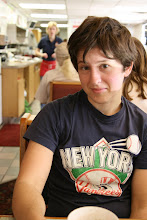 Yesterday I participated in a fundraising event called the Monster Drawing Rally for Southern Exposure, an artist run non-profit gallery here in San Francisco. The rules are like this: starting at 6:00pm, on the hour, thirty predetermined artists sit at tables in the middle of a ballroom and have an hour to make at least one drawing which will be sold for $60 the same night. Now, I know this may seem pretty straight-forward, but now add in a kajillion people and a dj and people fighting over drawings and all of the sweat from these kajillion fighting people and it turns into one of the most stressful spectacles I've ever taken part in. It's hard to start with a blank piece of paper and just make something happen while people are watching and with the second-hand of a clock wildly spinning, while sitting inside of a growing atmospheric cloud of human perspiration.
Yesterday I participated in a fundraising event called the Monster Drawing Rally for Southern Exposure, an artist run non-profit gallery here in San Francisco. The rules are like this: starting at 6:00pm, on the hour, thirty predetermined artists sit at tables in the middle of a ballroom and have an hour to make at least one drawing which will be sold for $60 the same night. Now, I know this may seem pretty straight-forward, but now add in a kajillion people and a dj and people fighting over drawings and all of the sweat from these kajillion fighting people and it turns into one of the most stressful spectacles I've ever taken part in. It's hard to start with a blank piece of paper and just make something happen while people are watching and with the second-hand of a clock wildly spinning, while sitting inside of a growing atmospheric cloud of human perspiration.So I made a drawing, using the photo above as the premise, and the drawing was mediocre, and the drawing sold. And it sold to someone I know, so I imagine I'll have to see it again, at the very least to sign it, which I forgot to do. It was the first drawing I've ever sold, though I didn't actually see a penny of the profit and though I am unsure if it even deserved to be traded for legal tender. Though the experience was harrowing, I've already been telling people that I want to do it again next year (I hate being bad at things! I'm determined that I can do better!).






 I looked through two boxes of studio portraits today, most of which are mounted in folders which make for a different picture-viewing experience than the straight-shots I prefer. When it's in a folder there's a certain level of anticipation and almost always inevitable disappointment. I'm considering selling this part of my collection for this exact reason. I also realized today that the portraits I once felt connection to are often just not doing it for me anymore. I think that perhaps I used to have some ability to see someone I missed in the faces of these strangers, and either I am resolved or have relinquished the role of that person in my life now, so the photos have lost their charm.
I looked through two boxes of studio portraits today, most of which are mounted in folders which make for a different picture-viewing experience than the straight-shots I prefer. When it's in a folder there's a certain level of anticipation and almost always inevitable disappointment. I'm considering selling this part of my collection for this exact reason. I also realized today that the portraits I once felt connection to are often just not doing it for me anymore. I think that perhaps I used to have some ability to see someone I missed in the faces of these strangers, and either I am resolved or have relinquished the role of that person in my life now, so the photos have lost their charm.
















 I went to a panel conversation on Friday between Ted Purves and Randall Szott, called "Let's Talk About Love: How to Succeed in Art Without Really Trying" which turned out to be a depressing way to slide into the weekend. Their conversation basically digressed as follows: Artists work really hard. Who are they working for? They are working for the art market. Their art-making is a job. Jobs aren't fun or expressive. What's the opposite of a job? Leisure is. So is love. You do what you love in your leisure. Leisure is free-time and relaxing. You cannot make art for an art-market simultaneously with leisure. You cannot love your job. So the best kind of art is when you don't try. The best kind of art might not even be art. Art is made to serve a purpose. Leisure is time spent without purpose. Therefore art cannot be genuine. Only leisure is genuine. (and on and on and on)
I went to a panel conversation on Friday between Ted Purves and Randall Szott, called "Let's Talk About Love: How to Succeed in Art Without Really Trying" which turned out to be a depressing way to slide into the weekend. Their conversation basically digressed as follows: Artists work really hard. Who are they working for? They are working for the art market. Their art-making is a job. Jobs aren't fun or expressive. What's the opposite of a job? Leisure is. So is love. You do what you love in your leisure. Leisure is free-time and relaxing. You cannot make art for an art-market simultaneously with leisure. You cannot love your job. So the best kind of art is when you don't try. The best kind of art might not even be art. Art is made to serve a purpose. Leisure is time spent without purpose. Therefore art cannot be genuine. Only leisure is genuine. (and on and on and on) 








